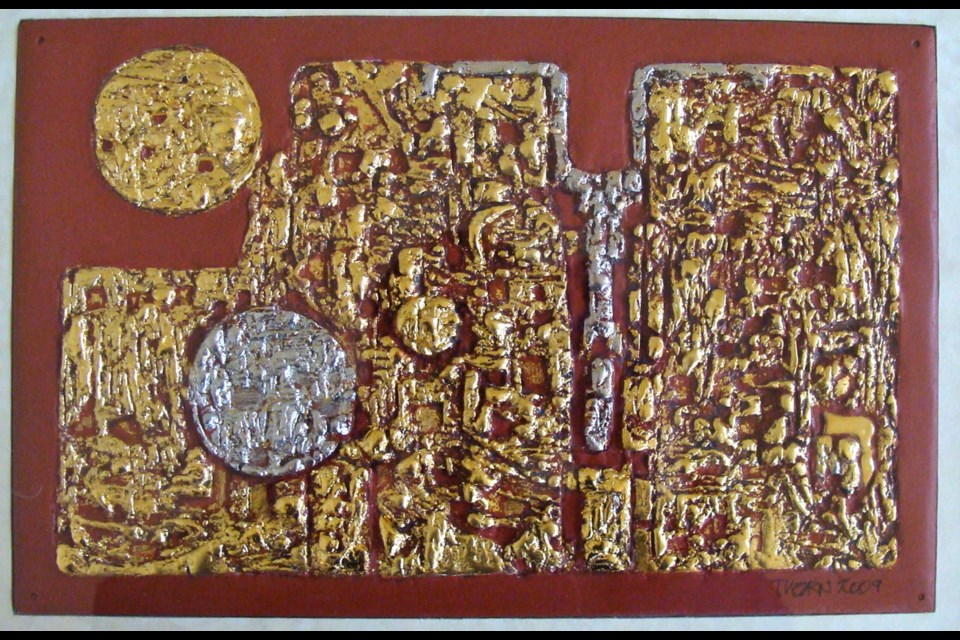My friend Tony hasn’t been well. In fact, though still in his home, he is in the care of Hospice Victoria. While physically disabled, his mind is clear and he is working, as he is able, in his studio. That’s what he lives for, for Anthony Thorn is an artist.
In the past few months, my visits with him have become more frequent, and Thorn’s candour is fascinating. It seems there’s just about nothing we don’t talk about. I’ve been learning about his philosophy and the formative events of his life, and especially his art practice. It occurred to me that I should write down what I’ve learned. And so I wrote a rather long essay on this artist (available online at aggv.bc.ca).
One afternoon he said to me that he’d like to have a show, for the purpose of selling off the work which remained in his home and studio. In this way, whatever is sold won’t have to become part of his estate, thus avoiding the complications that would attend that. I suggested that Art Rental and Sales, a part of the Art Gallery of Greater Victoria, would be the appropriate venue. In light of Thorn’s recent donation of $2.67 million to that Gallery, I thought they’d be sympathetic to the idea. His work certainly is worthy.
The gallery was happy to set a date, though Thorn admitted at the time he didn’t think he’d live to see the day. Whatever the future would hold, we got down to work. In all, he has about 20 of his art works hanging on the walls of his home. These include some early rather cubist oils, painted in Mexico and in Italy in the 1950s (and given to his parents many years ago). The larger abstract canvases, expressionist gestures of black enamel stained with colours like stained glass, are the sort of thing with which he made his reputation in Toronto in the 1960s. And then came the wall jewels.
Thorn arrived in Victoria in 1980, and he began to assemble precious bits of material he had been saving over the years — walnut wood, amber and opals, free-cast tin, pewter and gold. Some of these materials he attached to plaques that he made from gesso, which is essentially bonded marble dust. With a flexible-shaft grinding tool and dental implements, he carved these gesso tablets into abstract forms suggestive of the calligraphy of his paintings. And then he gilded them.
While meticulous about all his materials, Thorn is held in thrall by gold. He buys packets of gold leaf and gold foil of the utmost purity from an English supplier, and tenderly applies it to a ground tacky with size. Often he uses numerous layers of leaf, burnishing it with agate. Various carat levels and subtle alloys, as well as palladium, create a rich warm surface that is unequalled by any paint.
Sometimes he tints the surface with oil paint, and patiently scratches line drawings — sgraffito — into the gesso with a sharp point. As he spends hours at his work table, his youthful experience with metal-workers on the island of Corfu and observation of lacquer makers in Japan informs his practice. And, as he works, he thinks. You may assume that, in a house with so many books, Thorn is open to many influences. Departing from the pure abstraction which was the language of art in the 1960s, he eventually developed a unique syncretic imagery, an evolution from his study of Japanese ink painting and seal carving, Islamic calligraphy and his own Jewish faith.
Thorn is always questioning, and questing. His art is not just decorative, or a clever way to make a living. It is the manifestation of his life’s work and thought. The show we are just now putting together is, as much as anything could be, a summing-up of this artist’s life and work.
During his time in Victoria, I have followed Thorn’s work and reviewed his shows — at the Fran Willis Gallery, the Winchester Galleries (old and new) and Eclectic Gallery. Like many others, I enjoy the artworks he contributed to the Victoria and Oak Bay public libraries. And he has cultivated a small and admiring coterie of fans.
As Thorn and I continue our conversations, I realized that perhaps some of the collectors who have taken home more than 1200 artworks he created in his studio may not have come to terms with what his work is all about. The works are beautifully composed, elegantly coloured and rather mysterious. But what do they mean? This survey of Thorn’s manners of working will provide a new basis for understanding, better than any we have ever had.
Aside from the abstract and esoteric works, Thorn always treats his audience to a good old-fashioned painting, a wonderful realist study in oil glazes. You can look forward to a new painting of a Chinese pot with geraniums in this show and, as a bonus, an old favourite from the walls of his home: a white chrysanthemum.
“Flowers live for but a short time,” Thorn has written, “and the painter of them likewise; the paintings, however, if they are worth preserving, can last in the world for much longer, even generations.”
Whether a cosmic vision or the respectful delineation of a flower, the meditations on beauty which he has brought into being will likely last in the world for generations.
Art Sales and Rental, Art Gallery of Greater Victoria, 1040 Moss Street (250-384-4171, aggv.bc.ca) until April 6. A public reception will take place at the gallery's Art Sales and Rental on Saturday, March 29 from 2 to 4 p.m.
